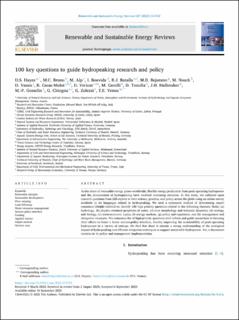100 key questions to guide hydropeaking research
| dc.contributor.author | Hayes, Daniel | |
| dc.contributor.author | Bruno, Maria Cristina | |
| dc.contributor.author | Alp, Maria | |
| dc.contributor.author | Boavida, Isabel | |
| dc.contributor.author | Batalla, Ramon J. | |
| dc.contributor.author | Bejarano, Maria Dolores | |
| dc.contributor.author | Noack, Markus | |
| dc.contributor.author | Vanzo, Davide | |
| dc.contributor.author | Casas-Mulet, Roser | |
| dc.contributor.author | Vericat, Damia | |
| dc.contributor.author | Carolli, Mauro | |
| dc.contributor.author | Tonolla, Diego | |
| dc.contributor.author | Halleraker, Jo Halvard | |
| dc.contributor.author | Gosselin, Marie-Pierre | |
| dc.contributor.author | Chiogna, Gabriele | |
| dc.contributor.author | Zolezzi, Guido | |
| dc.contributor.author | Venus, Terese E. | |
| dc.date.accessioned | 2023-09-25T07:55:03Z | |
| dc.date.available | 2023-09-25T07:55:03Z | |
| dc.date.created | 2023-09-20T14:58:27Z | |
| dc.date.issued | 2023 | |
| dc.identifier.issn | 1364-0321 | |
| dc.identifier.uri | https://hdl.handle.net/11250/3091627 | |
| dc.description.abstract | As the share of renewable energy grows worldwide, flexible energy production from peak-operating hydropower and the phenomenon of hydropeaking have received increasing attention. In this study, we collected open research questions from 220 experts in river science, practice, and policy across the globe using an online survey available in six languages related to hydropeaking. We used a systematic method of determining expert consensus (Delphi method) to identify 100 high-priority questions related to the following thematic fields: (a) hydrology, (b) physico-chemical properties of water, (c) river morphology and sediment dynamics, (d) ecology and biology, (e) socio-economic topics, (f) energy markets, (g) policy and regulation, and (h) management and mitigation measures. The consensus list of high-priority questions shall inform and guide researchers in focusing their efforts to foster a better science-policy interface, thereby improving the sustainability of peak-operating hydropower in a variety of settings. We find that there is already a strong understanding of the ecological impact of hydropeaking and efficient mitigation techniques to support sustainable hydropower. Yet, a disconnect remains in its policy and management implementation. | en_US |
| dc.language.iso | eng | en_US |
| dc.publisher | Elsevier | en_US |
| dc.rights | Navngivelse 4.0 Internasjonal | * |
| dc.rights.uri | http://creativecommons.org/licenses/by/4.0/deed.no | * |
| dc.title | 100 key questions to guide hydropeaking research | en_US |
| dc.title.alternative | 100 key questions to guide hydropeaking research | en_US |
| dc.type | Peer reviewed | en_US |
| dc.type | Journal article | en_US |
| dc.description.version | publishedVersion | en_US |
| dc.source.volume | 187 | en_US |
| dc.source.journal | Renewable and Sustainable Energy Reviews | en_US |
| dc.identifier.doi | 10.1016/j.rser.2023.113729 | |
| dc.identifier.cristin | 2177193 | |
| dc.relation.project | EC/H2020/101022905 | en_US |
| cristin.ispublished | true | |
| cristin.fulltext | original | |
| cristin.qualitycode | 1 |

